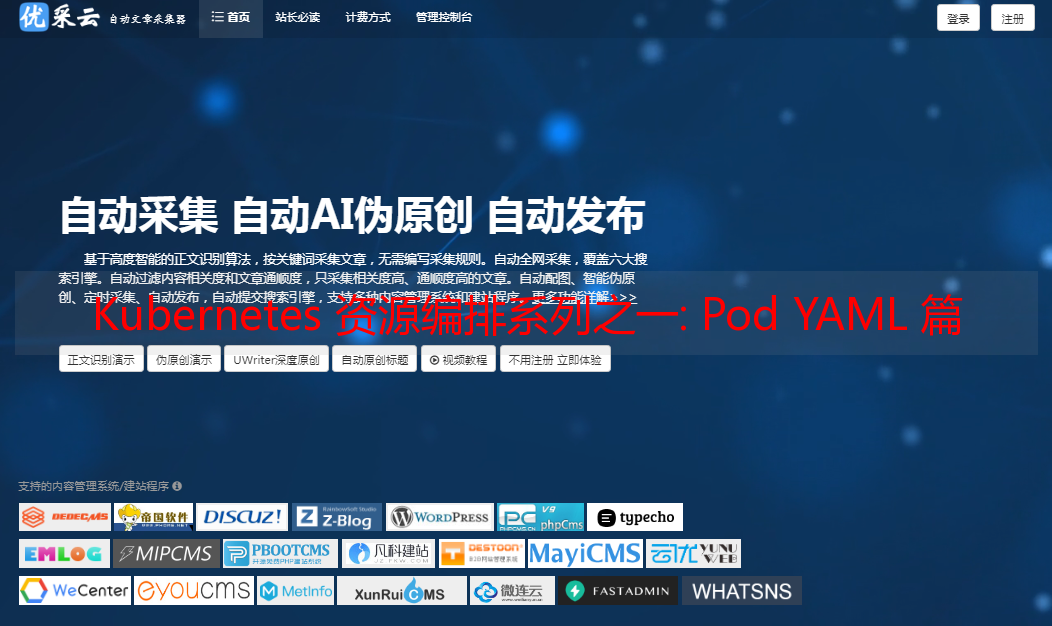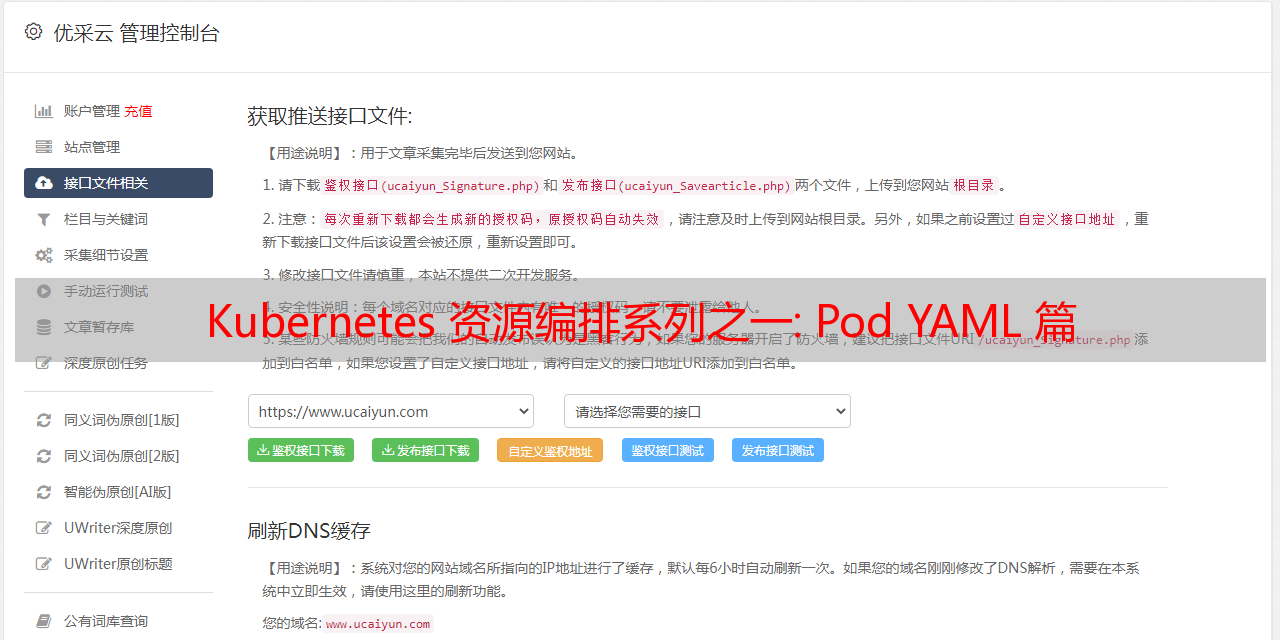Kubernetes 资源编排系列之一: Pod YAML 篇
优采云 发布时间: 2022-07-29 22:44Kubernetes 资源编排系列之一: Pod YAML 篇
作 者 |周虚(应金挺)
来 源 |阿里智能运维团队
SREWorks的开源吸引了大量用户来尝试部署和使用我们的产品,其中不乏一些初次接触Kubernetes的朋友。随着SREWorks云原生运维平台使用的持续深入,部分用户对于其中的原理和概念还存在一些困惑。因此,我们特推出《Kubernetes资源编排系列》,从底层的Pod YAML开始,逐步递进地讲解相关内容,希望能够解答大家对于Kubernetes的一些疑问,让用户对于云原生相关技术有更深入的了解。
01Pod 整体结构
Pod YAML的整体结构,可以初步分为Resource(资源)、Object(元数据)、Spec(规范)、Status(状态)。本文将会围绕这四部分一一展开。
02Resource(资源)- Rest API
k8s资源按照Scope可以分为Namespace资源、Cluster资源,Namespace在k8s可以认为是软租户的效果,实现资源层面的隔离,Pod资源就是属于Namespace资源,而Namespace不光体现在YAML参数中,也表现在k8s Rest API中。
Rest API的整体结构,以Pod举例
<p style="white-space: pre-wrap;margin: 0px 8px;font-size: 14px;font-weight: normal;word-spacing: 0px;letter-spacing: 0px;font-family: Consolas, Inconsolata, Courier, monospace;border-radius: 0px;color: rgb(169, 183, 198);background: rgb(40, 43, 46);padding: 0.5em;line-height: 1.75em;overflow-wrap: normal !important;word-break: normal !important;overflow: auto !important;display: -webkit-box !important;">apiVersion: v1<br />kind: Pod<br />metadata:<br /> name: test-pod<br /> namespace: default<br /></p>
基于上述YAML,可以明确出namespace为default, name为test-pod的Pod资源对象,也就是明确出Pod为Namespace资源,该Pod资源对象对应的apiVersion为v1,后续k8s自内联相关的Group为/api,自然而然,我们就将该对象的数据分离出来了:
基于上述的数据展示,apiserver自然而然会相应的注册出下列rest api:
后续基于扩展,我们就需要明确出method,这样一个真正完整的Rest API就诞生了。
03Object(元数据)
在rest api中明确了Resource的kind、apiVersion, 也确定了Object的namespace、name,作为凡是k8s资源对象都会引用的公共结构,自然也存在很多公共机制供使用。
<p style="white-space: pre-wrap;margin: 0px 8px;font-size: 14px;font-weight: normal;word-spacing: 0px;letter-spacing: 0px;font-family: Consolas, Inconsolata, Courier, monospace;border-radius: 0px;color: rgb(169, 183, 198);background: rgb(40, 43, 46);padding: 0.5em;line-height: 1.75em;overflow-wrap: normal !important;word-break: normal !important;overflow: auto !important;display: -webkit-box !important;">metadata:<br /> annotations:<br /> alibabacloud.com/owner: testdemo<br /> k8s.aliyun.com/pod-eni: "true"<br /> creationTimestamp: "2022-06-02T07:21:36Z"<br /> deleteTimestamp: "2022-06-02T07:22:51Z"<br /> labels:<br /> app: taihao-app-cn-shanghai-pre-cloud-resource<br /> pod-template-hash: 5bbb759f78<br /> name: testdemo-5bbb759f78-27v88<br /> namespace: default<br /> ownerReferences:<br /> - apiVersion: apps/v1<br /> blockOwnerDeletion: true<br /> controller: true<br /> kind: ReplicaSet<br /> name: testdemo-5bbb759f78<br /> uid: 9c3f268a-c0d1-4038-bb2b-b92928f45e3d<br /> resourceVersion: "60166035"<br /> uid: e4236960-8be2-41bf-ac44-e7460378afbb<br /></p>
观察上述YAML,我们将其整理一下,有这样一些字段:
label & labelSelector
Deployment 会根据自己的labelseletor:app=taihao-app-cluster 以及计算出podtemplate的hash lable:pod-template-hash: 5b8b879786 , 筛选出出符合的replicaset, replicaset再根据自己的labelselector 去筛选出符合的pods, 相应的服务发现service,也是通过labelselector去筛选出符合的Pod
Owner & GC(垃圾回收)
基于Pod的metadata.ownerReferences找寻到对应的replicaset,replicaset基于自身的metadata.ownerReferences 找寻到deploy;当deployment被删除后,基于原有owner构建的树状,回收原有的rs与pod。
Deploy & Replicaset
基于label&labelselector,明确了从上到下的筛选归纳;基于owner&GC,明确了关联资源的回收流程。
<p style="white-space: pre-wrap;margin: 0px 8px;font-size: 14px;font-weight: normal;word-spacing: 0px;letter-spacing: 0px;font-family: Consolas, Inconsolata, Courier, monospace;border-radius: 0px;color: rgb(169, 183, 198);background: rgb(40, 43, 46);padding: 0.5em;line-height: 1.75em;overflow-wrap: normal !important;word-break: normal !important;overflow: auto !important;display: -webkit-box !important;">apiVersion: apps/v1<br />kind: ReplicaSet<br />metadata:<br /> generation: 1<br /> labels:<br /> app: testdemo<br /> pod-template-hash: bcd889947<br /> name: testdemo-bcd889947<br /> namespace: taihao<br /> ownerReferences:<br /> - apiVersion: apps/v1<br /> blockOwnerDeletion: true<br /> controller: true<br /> kind: Deployment<br /> name: testdemo<br /> uid: 1dddc849-c254-4cf5-aec8-9e1c2b5e65af<br />spec:<br /> replicas: 1<br /> selector:<br /> matchLabels:<br /> app: testdemo<br /> pod-template-hash: bcd889947<br /> template:<br /> metadata:<br /> creationTimestamp: null<br /> labels:<br /> app: testdemo<br /> pod-template-hash: bcd889947<br /> spec:<br /> containers:<br /> - args:<br /> - -c<br /> - sleep 1000000<br /> command:<br /> - sh<br /> image: centos:7<br /> imagePullPolicy: IfNotPresent<br /> name: testdemo<br />status:<br /> fullyLabeledReplicas: 1<br /> observedGeneration: 1<br /> replicas: 1<br /></p>
replicaset.spec.replicas: 实例数,rs控制下的Pod个数
replicaset.spec.selector:基于label 筛选出对应的Pod
replicaset.spec.template:replicaset创建的Pod会基于podtemplate
replicaset.status:replicaset 当前管理Pod的状态
<p style="white-space: pre-wrap;margin: 0px 8px;font-size: 14px;font-weight: normal;word-spacing: 0px;letter-spacing: 0px;font-family: Consolas, Inconsolata, Courier, monospace;border-radius: 0px;color: rgb(169, 183, 198);background: rgb(40, 43, 46);padding: 0.5em;line-height: 1.75em;overflow-wrap: normal !important;word-break: normal !important;overflow: auto !important;display: -webkit-box !important;">apiVersion: apps/v1<br />kind: Deployment<br />metadata:<br /> labels:<br /> app: testdemo<br /> name: testdemo<br />spec:<br /> replicas: 1<br /> revisionHistoryLimit: 10<br /> selector:<br /> matchLabels:<br /> app: testdemo<br /> strategy:<br /> rollingUpdate:<br /> maxSurge: 25%<br /> maxUnavailable: 25%<br /> type: RollingUpdate<br /> template:<br /> metadata:<br /> creationTimestamp: null<br /> labels:<br /> app: testdemo<br /> spec:<br /> containers:<br /> - args:<br /> - -c<br /> - sleep 1000000<br /> command:<br /> - sh<br /> image: centos:7<br /> imagePullPolicy: IfNotPresent<br /> name: testdemo<br />status:<br /> availableReplicas: 1<br /> observedGeneration: 2<br /> readyReplicas: 1<br /> replicas: 2<br /> unavailableReplicas: 1<br /> updatedReplicas: 1<br /></p>
deploy.spec.replicas: deploy期望的pod实例格式
deploy.spec.revisionHistoryLimit:deploy 管理replicaset的保留三个月
deploy.spec.selector:deploy 筛选符合标签
deploy.spec.strategy:deploy的升级策略
deploy.template:deploy基于此模版要创建的pod格式
04Spec(规范)
Spec作为Pod的期望状态,一定程度上也覆盖了Pod完整生命周期的逻辑,Pod的生命周期分为以下阶段
Pod生命周期: Pending
Pod资源创建完毕后,处于还未调度阶段,这个时候scheduler(调度器)基于pod yaml本身的配置与节点资源状态情况,来进行调度。
scheduler会去分析podyaml,将其中的策略提取出来,与节点组中的节点配置进行匹配,若匹配成功后,会选出最佳节点,重新修改pod yaml,将spec.nodeName更新掉,完成整个调度环节
资源策略
资源策略表明Pod运行需要的资源情况,以demo为例,Pod需要2核4G的资源,那么调度过去的节点也需要有2核4G的资源剩余,Pod才能运行在该节点上
节点标签筛选策略
节点标签筛选策略,筛选节点是否存在topology.kubernetes.io/region: cn-hangzhou
亲和策略
亲和策略,有节点亲和与Pod亲和(Pod所在节点优先调度),常规来说可以优先满足亲和的节点上,当前例子就是节点亲和,满足标签disk-type=aaa或者disk-type=bbb
污点策略
污点策略,当节点上配置了污点,若Pod没有容忍该污点的策略,则Pod不允许调度到该节点上
Pod生命周期: Creating
当Pod调度完毕后,开始创建阶段,kubelet会基于pod.spec 期望状态来创建出Podkubelet 在创建Pod阶段,总共大致经历以下过程
上述阶段,会选择部分关键概念进行详细说明
image
<p style="white-space: pre-wrap;margin: 0px 8px;font-size: 14px;font-weight: normal;word-spacing: 0px;letter-spacing: 0px;font-family: Consolas, Inconsolata, Courier, monospace;border-radius: 0px;color: rgb(169, 183, 198);background: rgb(40, 43, 46);padding: 0.5em;line-height: 1.75em;overflow-wrap: normal !important;word-break: normal !important;overflow: auto !important;display: -webkit-box !important;">spec:<br /> containers:<br /> - image: testdemo:v1<br /> imagePullPolicy: Always<br /> name: test-config<br /> imagePullSecrets:<br /> - name: image-regsecret<br /></p>
containers
注意这个containers用的是复数,可以填多个容器镜像: 比如可以放 nginx 和 业务容器。这样做的好处是可以尽量减少业务容器中与业务无关的代码或进程。
container涉及很多配置,其中有涉及到volume、env、dnsconfig、host等基础配置
<p style="white-space: pre-wrap;margin: 0px 8px;font-size: 14px;font-weight: normal;word-spacing: 0px;letter-spacing: 0px;font-family: Consolas, Inconsolata, Courier, monospace;border-radius: 0px;color: rgb(169, 183, 198);background: rgb(40, 43, 46);padding: 0.5em;line-height: 1.75em;overflow-wrap: normal !important;word-break: normal !important;overflow: auto !important;display: -webkit-box !important;">spec:<br /> containers:<br /> - env:<br /> - name: TZ<br /> value: Asia/Shanghai<br /> image: testdemo:v1<br /> name: taihao-app-cn-shanghai-pre-share<br /> volumeMounts:<br /> - mountPath: /home/admin<br /> name: test-config<br /> readOnly: true<br /> dnsConfig:<br /> nameservers:<br /> - 100.100.1.1<br /> - 100.100.2.1<br /> options:<br /> - name: ndots<br /> value: "3"<br /> - name: timeout<br /> value: "3"<br /> - name: attempts<br /> value: "3"<br /> searches:<br /> - default.svc.cluster.local<br /> - svc.cluster.local<br /> - cluster.local<br /> hostAliases:<br /> - hostnames:<br /> - kubernetes<br /> - kubernetes.default<br /> - kubernetes.default.svc<br /> - kubernetes.default.svc.cluster.local<br /> ip: 1.1.1.1<br /> volumes:<br /> - configMap:<br /> defaultMode: 420<br /> name: test-config<br /> name: test-config<br /></p>
env:配置Pod的环境变量
dnsConfig:配置Pod的域名解析
hostALiases:配置/etc/hosts文件内容
volume/volumeMount: 配置文件挂载到容器内,也可以配置文件存储系统挂载到容器内
postStart
<p style="white-space: pre-wrap;margin: 0px 8px;font-size: 14px;font-weight: normal;word-spacing: 0px;letter-spacing: 0px;font-family: Consolas, Inconsolata, Courier, monospace;border-radius: 0px;color: rgb(169, 183, 198);background: rgb(40, 43, 46);padding: 0.5em;line-height: 1.75em;overflow-wrap: normal !important;word-break: normal !important;overflow: auto !important;display: -webkit-box !important;">containers:<br /> - image: testdemo:v1<br /> imagePullPolicy: Always<br /> lifecycle:<br /> postStart:<br /> exec:<br /> command:<br /> - /bin/sh<br /> - -c<br /> - sleep 5<br /></p>
当前poststart demo 是发起command命令,也可以发起http请求,主要作用可以作为资源部署以及环境准备。
Pod 生命周期: Running
在Pod running阶段的时候,Pod就迎来对其健康的检查,当前kubelet 提供三种方式判定
<p style="white-space: pre-wrap;margin: 0px 8px;font-size: 14px;font-weight: normal;word-spacing: 0px;letter-spacing: 0px;font-family: Consolas, Inconsolata, Courier, monospace;border-radius: 0px;color: rgb(169, 183, 198);background: rgb(40, 43, 46);padding: 0.5em;line-height: 1.75em;overflow-wrap: normal !important;word-break: normal !important;overflow: auto !important;display: -webkit-box !important;">spec:<br /> readinessGates:<br /> - conditionType: TestPodReady<br /> containers:<br /> - image: testdemo:v1<br /> imagePullPolicy: Always<br /> livenessProbe:<br /> failureThreshold: 3<br /> initialDelaySeconds: 45<br /> periodSeconds: 5<br /> successThreshold: 1<br /> tcpSocket:<br /> port: 8080<br /> timeoutSeconds: 1<br /> readinessProbe:<br /> failureThreshold: 3<br /> httpGet:<br /> path: /actuator/health<br /> port: 8989<br /> scheme: HTTP<br /> initialDelaySeconds: 25<br /> periodSeconds: 3<br /> successThreshold: 1<br /> timeoutSeconds: 1<br /></p>
readiness与liveness检查参数都是一致的
readiness、liveness虽然参数不一样,但对检验的结果行为不一致。
readinessGate 是Pod健康的扩展,kubelet会基于此,默认在pod.status.conditions上配置对应的condition, 比如当前例子readinessGate为conditionType: TestPodReady, 则相应就会有conditions
<p style="white-space: pre-wrap;margin: 0px 8px;font-size: 14px;font-weight: normal;word-spacing: 0px;letter-spacing: 0px;font-family: Consolas, Inconsolata, Courier, monospace;border-radius: 0px;color: rgb(169, 183, 198);background: rgb(40, 43, 46);padding: 0.5em;line-height: 1.75em;overflow-wrap: normal !important;word-break: normal !important;overflow: auto !important;display: -webkit-box !important;">status:<br /> conditions:<br /> - lastProbeTime: null<br /> lastTransitionTime: "2022-07-05T09:16:07Z"<br /> status: "false"<br /> type: TestPodReady<br /></p>
当该condition.status为false时,则Pod就会一直是不健康,哪怕readiness检查通过,直到第三方系统去操作更新Pod该condition.status为true,才可以将Pod变为健康,这样就可以接入更多的Pod健康指标。
Pod 生命周期: Terminating
client 在发起请求删除Pod的时候,实际上是配置
pod.metadata.deletionTimestamp,kubelet感知到后,开始进行Pod回收流程
整个Pod的回收周期,常规来说preStop—>SIGTERM—>SIGKILL
<p style="white-space: pre-wrap;margin: 0px 8px;font-size: 14px;font-weight: normal;word-spacing: 0px;letter-spacing: 0px;font-family: Consolas, Inconsolata, Courier, monospace;border-radius: 0px;color: rgb(169, 183, 198);background: rgb(40, 43, 46);padding: 0.5em;line-height: 1.75em;overflow-wrap: normal !important;word-break: normal !important;overflow: auto !important;display: -webkit-box !important;">lifecycle:<br /> preStop:<br /> exec:<br /> command:<br /> - /bin/sh<br /> - -c<br /> - sleep 5<br /></p>
当kubelet进行preStop后,开始发起SIGTERM给容器内进程,若超过总默认耗时30S(metadata.DeletionGracePeriodSeconds),则强制发起SIGKILL给容器,也就是prestop+SIGTERM总耗时不允许超过30s。
05Status(状态)
<p style="white-space: pre-wrap;margin: 0px 8px;font-size: 14px;font-weight: normal;word-spacing: 0px;letter-spacing: 0px;font-family: Consolas, Inconsolata, Courier, monospace;border-radius: 0px;color: rgb(169, 183, 198);background: rgb(40, 43, 46);padding: 0.5em;line-height: 1.75em;overflow-wrap: normal !important;word-break: normal !important;overflow: auto !important;display: -webkit-box !important;">status:<br /> conditions:<br /> - lastProbeTime: null<br /> lastTransitionTime: "2022-07-05T09:16:07Z"<br /> status: "True"<br /> type: TestPodReady<br /> - lastProbeTime: null<br /> lastTransitionTime: "2022-07-05T09:16:07Z"<br /> status: "True"<br /> type: Initialized<br /> - lastProbeTime: null<br /> lastTransitionTime: "2022-07-05T09:16:14Z"<br /> status: "True"<br /> type: Ready<br /> - lastProbeTime: null<br /> lastTransitionTime: "2022-07-05T09:16:14Z"<br /> status: "True"<br /> type: ContainersReady<br /> - lastProbeTime: null<br /> lastTransitionTime: "2022-07-05T09:16:07Z"<br /> status: "False"<br /> type: ContainerDiskPressure<br /> - lastProbeTime: null<br /> lastTransitionTime: "2022-07-05T09:16:07Z"<br /> status: "True"<br /> type: PodScheduled<br /> containerStatuses:<br /> - containerID: containerd://xxxxx<br /> image: docker.io/library/testdemo:v1<br /> imageID: docker.io/library/centos@sha256:xxxx<br /> lastState: {}<br /> name: zxtest<br /> ready: true<br /> restartCount: 0<br /> started: true<br /> state:<br /> running:<br /> startedAt: "2022-07-05T09:16:13Z"<br /> hostIP: 21.1.96.23<br /> phase: Running<br /> podIP: 10.11.17.172<br /> podIPs:<br /> - ip: 10.11.17.172<br /> qosClass: Guaranteed<br /> startTime: "2022-07-05T09:16:07Z"<br /></p>
基于上述YAML样例,将Pod status状态拆建出来分析一下:
通过以上Pod四个部分拆解,我们基本搞清了一个Pod在k8s下“从哪里来”的这个问题。本系列的后续的文章会对“到哪里去”这个问题继续展开:Kubernetes的魅力在于不仅仅是拉起一个工作负载,而是能够召之即来挥之即去地编排海量工作负载。
技 术 好 文
企 业 案 例
云 专 栏




